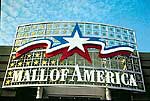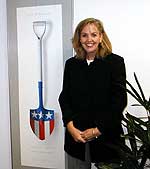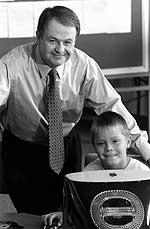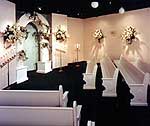By Bill Catlin
Minnesota Public Radio
August 9, 2002
The Mall of America turns 10 on Sunday. Despite waves of initial skepticism, the largest mall in America has drawn nearly 390 million visitors through its doors. The behemoth once dubbed the "megamistake" has a history of defying expectations.
| |
|
|
|
||
As the indoor roller coaster thunders overhead, Christine and Scott Craig and five family members are taking a midday break at Camp Snoopy, the mall's indoor amusement park. Like more than one-third of mall visitors, they're tourists - the Craigs drove the five hours from Sioux City, Iowa to see the mall.
"It's got a little bit for everybody," says Christine Craig. "It's got Camp Snoopy for the kids. It's got shopping for the adults."
"Besides that, it's the largest mall in America," says Jeanie Craig.
The path-breaking formula that brought the Craigs here combines more than 520 shops with restaurants and entertainment. Assisted by a nearby hub airport and Minnesota winters, the Mall of America draws some 40 million visits a year, many from afar. About 40 percent have traveled from beyond a 150-mile radius - about 6 percent from other countries.
The Mall's drawing power has defied early skeptics who doubted it would ever open.
| |
|
|
|
||
In the mid-1980s, the city of Bloomington was looking for a new use for the former Metropolitan Stadium site. In July, 1985, Nader Ghermezian of the Triple Five Group in Edmonton, Alberta, Canada laid out the original vision for the project - which never came to pass.
"We are proposing the world's largest indoor lake. With waves six foot high by 360 feet wide, that you can do surfing and water-skiing indoor," Ghermezian said at the time. "Can you imagine in January - you walk out of your house and you come and do surfing? This is what we are proposing for you today."
Those grandiose plans prompted enduring skepticism in Minnesota. But Melvin Simon and Associates, a big shopping center developer, signed on to develop and manage the project. Teachers Insurance and Annuity Association of America, part of the firm TIAA-CREF, invested in the project.
Even scaled back, the mall cost $680 million to develop and build. Maureen Bausch, the mall's vice president of business development, says the chorus of doubt continued.
| |
|
|
|
||
"It's going to fail. It's not going to succeed. Who would ever go there? And no one would believe that it would actually open the doors," Bausch recalls. "Finally, when we actually had an opening date, and we were inviting people, they said, 'Well, we'll come once, but we're not coming back. We will hate it.'"
Hans Eisenbeis remembers that feeling. The Minnesota native is editor of The Rake magazine in Minneapolis, and former senior editor of Spin Magazine, the influential music and pop culture publication.
"At the time I felt it was this huge, ridiculous, behemoth idol of consumerism, and I just wanted to have nothing to do with it," Eisenbeis says.
To this day, some Twin Cities residents wear it as a badge of honor that they've never set foot in the mall. But not Eisenbeis, who says his kids love Camp Snoopy, and the mall's vast offerings have an appeal.
"It's either your cup of tea or it's not. And go if it is - and if it's not, don't," says Eisenbeis. "I think we've all sort of learned to live with the Mall of America, whether you like it or not."
|
"It's not very modest. It doesn't know its place. It's got very grandiose expectations of itself. But then, part of us feels awfully proud that that thing is here."
- Hans Eisenbeis, on the Mall of America being "Minnesotan" |
Eisenbeis says he started wondering if he had been taking the mall too seriously after his fiancee finally found the right pair of wedding shoes at the mall.
The mall's effect on other Twin Cities retailers has also defied expectations, even as experts disagree about the damage it inflicted. University of St. Thomas marketing professor Dave Brennan co-authored a study that examined store turnover at Twin Cities malls over a 15-year period.
"We found that during the period from about 1990 to 1994 there was a disruptive influence, but it was only moderate. It was not strong, not nearly as much as we had anticipated," he says.
Brennan says he thinks the Twin Cities' strong population and income growth over the 1990s helped buffer the mall's impact. But Minneapolis retail consultant James McComb says it was still significant. McComb says the megamall added roughly as much retail space as already existed in downtown Minneapolis, but Twin Cities area malls had underestimated the hit.
"The mall owners were shocked at the impact it was having on their properties," says McComb. "Most of them either renovated before Mall of America opened, or they renovated shortly thereafter, in an attempt to update their malls. And even with the renovations, they were suffering."
| |
|
|
|
||
Still, McComb says the mall attracts a large number of visitors from outside the Twin Cities, helping to expand the total retail pie.
The mall may also have fallen short of the owners' original financial expectations. Mall officials are tight-lipped about finances, but insist everyone's happy.
They don't dispute reports indicating that in 1999, the value of the mall was less than the cost to build it. Despite a booming economy, the operating profit that year was an estimated 6 percent of the cost of construction. That's well below the 8 percent annual return of TIAA's Real Estate account.
And the surprises are not limited to the realm of business.
"When I started, I thought this place was really tacky," says independent filmmaker Melody Gilbert.
Gilbert recently completed a documentary on the Chapel of Love, a for-profit wedding chapel and bridal boutique that opened in the megamall's second year.
"I had a secret agenda, where I really believed that this is tacky and we are going to find the tickiest, tackiest people in the world getting married here. But that wasn't the case for me at all," Gilbert says.
| |
|
|
|
||
Gilbert says she found the chapel's customers were often people whose path to the altar lay outside the traditional route - people with prior marriages, for example. But she says the commercial venue didn't cheapen the moment.
"I was sort of surprised about that too, about how emotional I felt in most of the ceremonies. It's this little corner of the mall, and you know, I'm crying. It was a really strange experience because you don't expect it when you're at a mall," she says.
The Chapel of Love is one part of an institution that mall officials say has given Minnesota an international reputation as a shopping destination. The Rev. Gary Reierson, president of the Greater Minneapolis Council of Churches, says he doesn't mind the mall, but he gently laments its identification with Minnesota.
"It's just that I'm more proud of things like the Mayo Clinic, or Minnesota Opera or Minnesota Orchestra, or the Art Institute, or the lakes or the culture," says Reierson. "There are a lot of things about Minnesota that I've very proud of, which is why I live here, and would hope that people from other places would know those things about my state that I'm most proud of."
In the wake of Sept. 11, the mall appeared a potential terror target, spotlighting its prominence as a symbol of american consumer culture. Hans Eisenbeis of The Rake magazine says even though Minnesotans have learned to live with the mall, it challenges expectations about what's Minnesotan.
"It's not very modest. It doesn't know its place. It's got very grandiose expectations of itself," says Eisenbeis. "But then, part of us feels awfully proud that that thing is here, too."
We're conflicted, Eisenbeis says. Do we want to be known as home to America's biggest mall? Yes, he says - if it puts Minnesota on the map in a good way.
Whether it does or not, more is planned. Phase two of the megamall is expected to add up to five million more square feet, which might include hotels, office space, retail, restaurants and entertainment.
More Information




